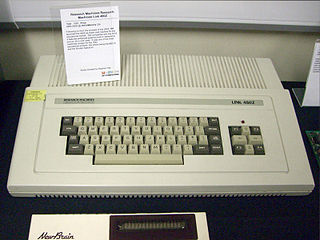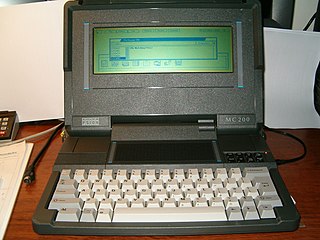
The Amstrad CPC is a series of 8-bit home computers produced by Amstrad between 1984 and 1990. It was designed to compete in the mid-1980s home computer market dominated by the Commodore 64 and the ZX Spectrum, where it successfully established itself primarily in the United Kingdom, France, Spain, and the German-speaking parts of Europe.

CP/M, originally standing for Control Program/Monitor and later Control Program for Microcomputers, is a mass-market operating system created in 1974 for Intel 8080/85-based microcomputers by Gary Kildall of Digital Research, Inc. CP/M is a disk operating system and its purpose is to organize files on a magnetic storage medium, and to load and run programs stored on a disk. Initially confined to single-tasking on 8-bit processors and no more than 64 kilobytes of memory, later versions of CP/M added multi-user variations and were migrated to 16-bit processors.

The Amstrad PCW series is a range of personal computers produced by British company Amstrad from 1985 to 1998, and also sold under licence in Europe as the "Joyce" by the German electronics company Schneider in the early years of the series' life. The PCW, short for Personal Computer Word-processor, was targeted at the word processing and home office markets. When it was launched the cost of a PCW system was under 25% of the cost of almost all IBM-compatible PC systems in the UK, and as a result the machine was very popular both in the UK and in Europe, persuading many technophobes to venture into using computers. The series is reported to have sold 1.5 million units. However the last two models, introduced in the mid-1990s, were commercial failures, being squeezed out of the market by the falling prices, greater capabilities and wider range of software for IBM-compatible PCs.
Kaypro Corporation was an American home and personal computer manufacturer based in Solana Beach in the 1980s. The company was founded by Non-Linear Systems (NLS) to compete with the popular Osborne 1 portable microcomputer. Kaypro produced a line of rugged, "luggable" CP/M-based computers sold with an extensive software bundle which supplanted its competitors and quickly became one of the top-selling personal computer lines of the early 1980s.

The Osborne 1 is the first commercially successful portable computer, released on April 3, 1981 by Osborne Computer Corporation. It weighs 24.5 lb (11.1 kg), cost US$1,795, and runs the CP/M 2.2 operating system. It is powered from a wall socket, as it has no on-board battery, but it is still classed as a portable device since it can be hand-carried when the keyboard is closed.

Compaq's first computers' form factors were portable, also called "luggables", and then "lunchbox computers", and together constituted the Compaq Portable series. These computers measured approximately 16 inches (410 mm) deep, 8 inches (200 mm) tall, and approximately 20 inches (510 mm) wide. As the products evolved, laptops and notebooks were created offing a new level of portability that caused the market to explode.

The TRS-80 Model 100 is a portable computer introduced in April 1983. It is one of the first notebook-style computers, featuring a keyboard and liquid-crystal display, in a battery-powered package roughly the size and shape of a notepad or large book. The 224-page, spiral-bound User Manual is nearly the same size as the computer itself.

The Compaq Portable is an early portable computer which was one of the first IBM PC compatible systems. It was Compaq Computer Corporation's first product, to be followed by others in the Compaq Portable series and later Compaq Deskpro series. It was not simply an 8088-CPU computer that ran a Microsoft DOS as a PC "work-alike", but contained a reverse-engineered BIOS, and a version of MS-DOS that was so similar to IBM's PC DOS that it ran nearly all its application software. The computer was also an early variation on the idea of an "all-in-one".

The Epson QX-10 is a microcomputer running CP/M or TPM-III which was introduced in 1983. It was based on a Zilog Z80 microprocessor, running at 4 MHz, provided up to 256 KB of RAM organized in four switchable banks, and included a separate graphics processor chip (µPD7220) manufactured by NEC to provide advanced graphics capabilities. In the USA and Canada, two versions were launched; a basic CP/M configuration with 64 KB RAM and the HASCI configuration with 256 KB RAM and the special HASCI keyboard to be used with the bundled application suite, called Valdocs. TPM-III was used for Valdocs and some copy protected programs like Logo Professor. The European and Japanese versions were CP/M configurations with 256 KB RAM and a graphical Basic interpreter.

The Rainbow 100 is a microcomputer introduced by Digital Equipment Corporation (DEC) in 1982. This desktop unit had a monitor similar to the VT220 and a dual-CPU box with both 4 MHz Zilog Z80 and 4.81 MHz Intel 8088 CPUs. The Rainbow 100 was a triple-use machine: VT100 mode, 8-bit CP/M mode, and CP/M-86 or MS-DOS mode using the 8088. It ultimately failed to in the marketplace which became dominated by the simpler IBM PC and its clones which established the industry standard as compatibility with CP/M became less important than IBM PC compatibility. Writer David Ahl called it a disastrous foray into the personal computer market. The Rainbow was launched along with the similarly packaged DEC Professional and DECmate II which were also not successful. The failure of DEC to gain a significant foothold in the high-volume PC market would be the beginning of the end of the computer hardware industry in New England, as nearly all computer companies located there were focused on minicomputers for large organizations, from DEC to Data General, Wang, Prime, Computervision, Honeywell, and Symbolics Inc.

The Gavilan SC is a laptop computer that was the first ever to be marketed as a "laptop". The computer ran on an Intel 8088 microprocessor running at 5 MHz and sported a touchpad for a pointing device, one of the first computers to do so. The laptop was developed by Manuel "Manny" Fernandez and released by the Gavilan Computer Corporation, the company he founded and owned, in May 1983.

The Epson HX-20 was the first "true" laptop computer. It was invented in July 1980 by Yukio Yokozawa, who worked for Suwa Seikosha, now the Seiko Epson subsidiary of the Japanese Seiko Group, receiving a patent for the invention. It was announced in 1981 as the HC-20 in Japan, and was introduced by Epson in North America as the HX-20 at the 1981 COMDEX computer show in Las Vegas, where it drew significant attention for its portability. It had a mass-market release in July 1982, as the HC-20 in Japan and as the Epson HX-20 in North America. The size of an A4 notebook and weighing 1.6 kg, it was hailed by BusinessWeek magazine as the "fourth revolution in personal computing".
MSX-DOS is a discontinued disk operating system developed by Microsoft's Japan subsidiary for the 8-bit home computer standard MSX, and is a cross between MS-DOS v1.25 and CP/M-80 v2.2.

The Research Machines 380Z was an early 8-bit microcomputer produced by Research Machines in Oxford, England, from 1977 to 1985.

The Toshiba T1000 is a discontinued laptop computer manufactured by the Toshiba Corporation in 1987. It has a similar specification to the IBM PC Convertible, with a 4.77 MHz 80C88 processor, 512 KB of RAM, and a monochrome CGA-compatible LCD. Unlike the Convertible, it includes a standard serial port and parallel port, connectors for an external monitor, and a real-time clock.

The LINK 480Z was an 8-bit microcomputer produced by Research Machines Limited in Oxford, England, during the early 1980s.

The history of laptops describes the efforts, begun in the 1970s, to build small, portable Personal Computers that combine the components, inputs, outputs and capabilities of a Desktop Computer in a small chassis.

The Epson PX-4 is a portable CP/M based computer introduced in 1985. The screen was 40×8 characters physical, but 80×25 or 40×50 virtual, making it almost compatible with the Epson PX-8 Geneva. It could be operated from a Nickel-Cadium battery pack, 4xAA batteries, or a 6V 600mA DC power supply.

The Psion MC series is a line of laptop computers made by Psion PLC and launched in 1989.

















